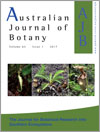Australian Journal of Botany
Volume 65
Number 1 2017
Here we analysed the relation between the accumulation of silica-made particles and environmental and biological factors, a relation scarcely known in pampean grasses. Grasses, along with other plants, produce glass-like particles in their tissues which have multiple functions during plant growth and development. Understanding the factors affecting silica accumulation in plants has implications for managing agroecosystems and Si-requiring crops such as rice.
Arillastrum gummiferum (Myrtaceae) and Nothofagus aequilateralis (Nothofagaceae) are two tree species known to dominate the upper canopy of some rainforests on ultramafic substrates in New Caledonia. Structure, diversity and composition of these forests were investigated to better understand the ecological mechanisms leading to their monodominance.
Six Eucalyptus species with diverse seed sizes were sown in vertosol soils in a glasshouse to investigate the influence of sowing depth and three soil-moisture scenarios on seedling emergence. All species had greater emergence when sown superficially but responded differently to the watering treatments. Seed size had little effect.
As parasitic plants, mistletoes are functionally adapted to use host resources for their own growth and reproduction. As a response to mistletoe infection, infected branches produce leaves with morpho-physiological traits that allow higher resource conservation.
Xerothamnella herbacea is an endangered herbaceous species from the Brigalow Belt impacted by gas pipeline developments. Most populations consisted of less than 100 plants with moderate to low genetic diversity and inbred. Geographic proximity does not predict genetic similarity of populations and diversity is not correlated with population size.
The highly toxic species of Ricinus communis L., was investigated for leaf anatomy, histochemistry and composition of secondary metabolites. Leaves of simple structure with numerous idioblasts and strong positive reaction to histochemical reagents for terpenes, flavonoids, phenolics and alkaloids. Among the secondary metabolites detected is the highly toxic alkaloid ricinine.
The relationships between anatomy and physico-chemical properties of plant assimilatory organs (e.g. leaves) have been rarely considered, particularly so in carnivorous plants. The study was on five Nepenthes species, focussing on comparative anatomy of their leaves and conjoint pitchers, as well as on linkages of their tissue dimensions with organ life span and chemistry. The leaf stomata (for photosynthesis) and pitcher-wall glands (for digestive product transfer), despite differences in structure and function, are similar in epidermal origin and in their density–size relationships.
An in vitro protocol for Callerya speciosa regeneration through embryogenesis was developed using the anthers containing late uninucleate stage microspore as the explants. The embryonic callus induced from the anthers developed into embryos and plants. So, a highly efficient system for regenerating C. speciosa using anther culture was established.
Seasonally dry tropical forests (SDTFs) make up a globally important biome for biodiversity conservation, and many such forests occur in poorly studied isolated ecological islands or enclaves. Understanding temporal change in these forests is important for their conservation, and in a SDTF enclave in Minas Gerais, Brazil, we found evidence of shifting vegetation dynamics within these forests. Our results highlight the need for longer term monitoring of enclave SDTF patches.




